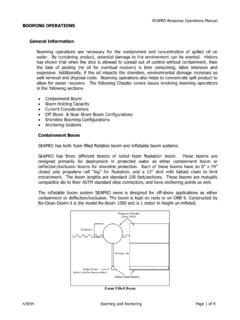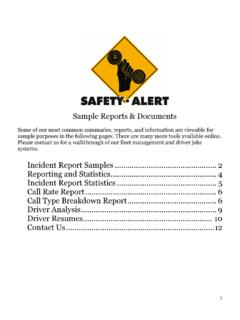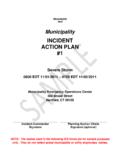Transcription of What Is the Incident Command System (ICS) - …
1 What Is the Incident Command System (ICS)? This section provides a basic overview (directly below) and material on concepts and principles. It is derived from training materials distributed by the Federal Emergency Management Agency (FEMA). 5-1999 ICS is the model tool for Command , control, and coordination of a response and provides a means to coordinate the efforts of individual agencies as they work toward the common goal of stabilizing the Incident and protecting life, property, and the environment. ICS uses principles that have been proven to improve efficiency and effectiveness in a business setting and applies the principles to emergency response. Why do you need to know about ICS? We live in a complex world in which responding to emergencies, from single-car accidents to large-scale disasters, often requires cooperation among several agencies. In an emergency, you and other personnel from your agency may be called upon to help with the response.
2 Given the current movement toward using an ICS structure for emergency response, it is likely, therefore, that you will function in an ICS environment. In an emergency, you may not be working for your day-to-day supervisor, or you may be working in a different location. Thus, emergency response operations are not "business as usual." This unit will provide you with information that you will need to work in an ICS environment, including the rationale for using ICS and how ICS can be used to manage all types of incidents. It also will describe the basic ICS organization, how ICS can form the basis for an effective emergency management System , and how ICS can enhance EOC operations. When Is ICS Used? ICS has been proven effective for responding to all types of incidents, including: Hazardous materials (HAZMAT) incidents Planned events (celebrations, parades, concerts, official visits, etc.)
3 Response to natural hazards Single and multiagency law enforcement incidents Lack of comprehensive resource management strategy Fires Incidents involving multiple casualties Multijurisdictional and multiagency incidents Air, rail, water, or ground transportation accidents Wide-area search and rescue missions Private sector emergency management program Federal law requires the use of ICS for response to HAZMAT incidents. Many States are adopting ICS as their standard for responding to all types of incidents. ICS has been endorsed by the American Public Works Association and the International Association of Chiefs of Police (IACP) and has been adopted by the National Fire Academy as its standard for Incident response. ICS is included in the National Fire Protection Association (NFPA) "Recommended Practice for Disaster Management." ICS is also part of the National Interagency Incident Management System (NIIMS).
4 ICS History ICS was developed in the 1970s in response to a series of major wildland fires in southern California. At that time, municipal, county, State, and Federal fire authorities collaborated to form the Firefighting Resources of California Organized for Potential Emergencies (FIRESCOPE). FIRESCOPE identified several recurring problems involving multiagency responses, such as: Nonstandard terminology among responding agencies. Lack of capability to expand and contract as required by the situation. Nonstandard and nonintegrated communications. Lack of consolidated action plans. Lack of designated facilities. Efforts to address these difficulties resulted in the development of the original ICS model for effective Incident management. Although originally developed in response to wildfires, ICS has evolved into an all-risk System that is appropriate for all types of fire and non-fire emergencies.
5 Much of the success of ICS has resulted directly from applying: A common organizational structure Key management principles in a standardized way The remainder of this unit will introduce these concepts and principles. Many incidents--whether major accidents (such as HazMat spills), minor incidents (such as house fires and utility outages), or emergencies and major disasters (such as tornadoes, hurricanes, and earthquakes)--require a response from a number of different agencies. Regardless of the size of the Incident or the number of agencies involved in the response, all incidents require a coordinated effort to ensure an effective response and the efficient, safe use of resources. No single agency or department can handle an emergency situation of any scale alone. Everyone must work together to manage the emergency. To coordinate the effective use of all of the available resources, agencies need a formalized management structure that lends consistency, fosters efficiency, and provides direction during a response.
6 The ICS organization is built around five major components: Command Planning Operations Logistics Finance/Administration These five major components are the foundation upon which the ICS organization develops. They apply during a routine emergency, when preparing for a major event, or when managing a response to a major disaster. In small-scale incidents, all of the components may be managed by one person, the Incident Commander. Large-scale incidents usually require that each component, or section, is set up separately. As you will see later in this unit, each of the primary ICS sections may be divided into smaller functions as needed. The ICS organization has the capability to expand or contract to meet the needs of the Incident , but all incidents, regardless of size or complexity, will have an Incident Commander. A basic ICS operating guideline is that the Incident Commander is responsible for on-scene management until Command authority is transferred to another person, who then becomes the Incident Commander.
7 Incident Command The Command function is directed by the Incident Commander, who is the person in charge at the Incident , and who must be fully qualified to manage the response. Major responsibilities for the Incident Commander include: Performing Command activities, such as establishing Command and establishing the ICP Protecting life and property Controlling personnel and equipment resources Maintaining accountability for responder and public safety, as well as for task accomplishment Establishing and maintaining an effective liaison with outside agencies and organizations, including the EOC, when it is activated Establishing Command Ensuring responder safety Assessing Incident priorities Determining operational objectives Developing and implementing the Incident Action Plan ( Incident Action Plan) Developing an appropriate organizational structure Maintaining a manageable span of control Managing Incident resources Coordinating overall emergency activities Coordinating the activities of outside agencies Authorizing the release of information to the media Keeping track of costs An effective Incident Commander must be assertive, decisive, objective, calm, and a quick thinker.
8 To handle all of the responsibilities of this role, the Incident Commander also needs to be adaptable, flexible, and realistic about his or her limitations. The Incident Commander also needs to have the capability to delegate positions appropriately as needed for an Incident . Initially, the Incident Commander will be the senior first-responder to arrive at the scene. As additional responders arrive, Command will transfer on the basis of who has primary authority for overall control of the Incident . As incidents grow in size or become more complex, the responsible jurisdiction or agency may assign a more highly qualified Incident Commander. At transfer of Command , the outgoing Incident Commander must give the incoming Incident Commander a full briefing and notify all staff of the change in Command . As incidents grow, the Incident Commander may delegate authority for performing certain activities to others, as required.
9 When expansion is required, the Incident Commander will establish other Command Staff positions: Information Officer, Safety Officer, Liaison Officer. The Information Officer handles all media inquiries and coordinates the release of information to the media with the Public Affairs Officer at the EOC The Safety Officer monitors safety conditions and develops measures for ensuring the safety of all assigned personnel The Liaison Officer is the on-scene contact for other agencies assigned to the Incident The Incident Commander will base the decision to expand (or contract) the ICS organization on three major Incident priorities: Life safety. The Incident Commander's first priority is always the life safety of the emergency responders and the public. Incident stability. The Incident Commander is responsible for determining the strategy that will: Minimize the effect that the Incident may have on the surrounding area.
10 Maximize the response effort while using resources efficiently. The size and complexity of the Command System that the Incident Commander develops should be in keeping with the complexity ( , level of difficulty in the response) of the Incident , not the size (which is based on geographic area or number of resources). Property conservation. The Incident Commander is responsible for minimizing damage to property while achieving the Incident objectives. As incidents become more involved, the Incident Commander can activate additional General Staff sections (that is, Planning, Operations, Logistics, and/or Finance/Administration), as necessary. Planning Section In smaller events, the Incident Commander is responsible for planning, but when the Incident is of larger scale, the Incident Commander establishes the Planning Section. The Planning Section's function includes the collection, evaluation, dissemination, and use of information about the development of the Incident and status of resources.








